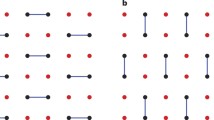Abstract
In this paper, we discuss quantum algorithms that, for a given plaintextm o and a given ciphertextc o, will find a secret key,k o, satisfyingc o=E(k o,m o), where an encryption algorithm,E, is publicly available. We propose a new algorithm suitable for an NMR (Nuclear Magnetic Resonance) computer based on the technique used to solve the counting problem. The complexity of, our algorithm decreases as the measurement accuracy of the NMR computer increases. We discuss the possibility that the proposed algorithm is superior to Grover’s algorithm based on initial experimental results.
Similar content being viewed by others
References
Bennett, C. H., “Logical Reversibility of Computation,”IBM J. Res. Dev., 6, pp. 525–532, 1973.
Boyer, M., Brassard, G., Hoyer, P. and Tapp. A., “Tight Bounds on Quantum Searching,”quant-ph/9605034.
Chuang, I. L., Gershenfeld, N., Kubinec, M. G. and Leung, D. W., “Bulk Quantum Computation with Nuclear Magnetic Resonance: Theory and Experiment,” inProc. of R. Soc. Lond., A454, pp. 447–467, 1998.
Deutsch, D., “Quantum Theory, the Church-Turing Principle and the Universal Quantum Computer,” inProc. of R. Soc. Lond. A400, pp. 97–117, 1985.
Gershenfeld, N. and Chuang, I. L., “Bulk Spin-Resonance Quantum Computation,”Science, 275, pp. 350, 1997.
Grover, L. K., “Quantum Mechanics helps in Searching for a Needle in a Haystack,”quant-ph/9605043.
Ohta, K., Nishino, T. and Aoki, K., “Another Exhaustive Key Search of Common-Key Cryptosystems,” inProc. of ERATO Workshop on Quantum Information Science 2001, 2001.
Nishino, T., “A Mathematical Theory of NMR Quantum Computations,” inProc. of 2000 International Conference on Information Society in the 21st Century, IS2000.
Shor, P., “Polynomial-time Algorithm for Prime Factorization and Discrete Logarithms on a Quantum Computer,”SIAM Journal on Computing, 26, pp. 14840–1509, October 1997.
Vandersypen, L. M. K., Steffen, M., Breyta, G., Yannoni, C. S., Sherwood, M. H. and Chuang, I. L., “Experimental Realization of Shor’s Quantum Factoring Algorithm Using Nuclear Magnetic Resonance,”Nature, 414, pp. 883–887, December 2001.
Author information
Authors and Affiliations
Corresponding author
Additional information
Kazuo Ohta, Dr.S.: He is Professor of Faculty of Electro-Communications at the University of Electro-Communications, Japan. He received B.S., M.S., and Dr. S. degrees from Waseda University, Japan, in 1977, 1979, and 1990, respectively. He was researcher of NTT (Nippon Telegraph and Telephone Corporation) from 1979 to 2001, and was visiting scientist of Laboratory for Computer Science e of MIT (Massachusetts Institute of Technology) in 1991–1992 and visiting Professor of Applied Mathematics of MIT in 2000. He is presently engaged in research on Information Security, and theoretical computer science. Dr. Ohta is a member of IEEE, the International Association for Cryptologic Research, the Institute of Electronics, Information and Communication Engineers and the Information Processing Society of Japan.
Tetsuro Nishino,: He received the B.S., M.S. and, D.Sc. degrees in mathematics from Waseda University, in 1982, 1984, and 1991 respectively. From 1984 to 1987, he joined Tokyo Research Laboratory, IBM Japan. From 1987 to 1992, he was a Research Associate of Tokyo Denki University, and from 1992 to 1994, he was an Associate Professor of Japan Advanced Institute of Science and Technology, Hokuriku. He is presently an Associate Professor in the Department of Communications and Systems Engineering, the University of Electro-Communications. His main interests are circuit complexity theory, computational learning theory and quantum complexity theory.
Seiya Okubo,: He received the B.Eng. and M.Eng. degrees from the University of Electro-Communications in 2000 and 2002, respectively. He is a student in Graduate School of Electro-Communications, the University of Electro-Communications. His research interests include quantum complexity theory and cryptography.
Noboru Kunihiro, Ph.D.: He is Assistant Professor of the University of Electro-Communications. He received his B. E., M. E. and Ph. D. in mathematical engineering and information physics from the University of Tokyo in 1994, 1996 and 2001, respectively. He had been engaged in the research on cryptography and information security at NTT Communication Science Laboratories from 1996 to 2002. Since 2002, he has been working for Department of Information and Communication Engineering of the University of Elector-Communications. His research interests include cryptography, information security and quantum computations. He was awarded the SCIS’97 paper prize.
About this article
Cite this article
Ohta, K., Nishino, T., Okubo, S. et al. A quantum algorithm using NMR computers to break secret-key cryptosystems. New Gener Comput 21, 347–361 (2003). https://doi.org/10.1007/BF03037309
Received:
Revised:
Issue Date:
DOI: https://doi.org/10.1007/BF03037309




